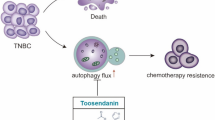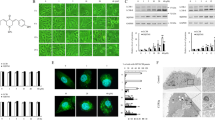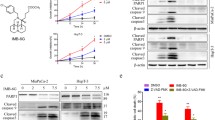Abstract
Autophagy is a homeostatic process that recycles damaged organelles and long-lived proteins by delivering them in double-membrane vesicles to lysosomes for degradation. Autophagy has a prominent role in survival, proliferation, and resistance of tumors in metabolic and chemotherapeutic stress conditions. Clinical trials with chloroquine—a known autophagy inhibitor—were unable to achieve complete autophagy inhibition in vivo, warranting the search for more potent autophagy inhibitors. In a process of exploring the mechanism of action of previously identified cytotoxic s-triazine analogs, we discovered that both IITZ-01 and IITZ-02 act as potent autophagy inhibitors. Treatment with these compounds resulted in the vacuolated appearance of cells due to their specific accumulation in lysosomes. In addition, these basic compounds also deacidify lysosomes as evidenced by the decrease in lysotracker red staining and inhibit maturation of lysosomal enzymes leading to lysosomal dysfunction. IITZ-01 and IITZ-02 enhance autophagosome accumulation but inhibit autophagosomal degradation by impairing lysosomal function, finally resulting in the inhibition of autophagy. Interestingly, compound IITZ-01 exhibited more than 10-fold potent autophagy inhibition along with 12- to 20-fold better cytotoxic action than CQ. IITZ-01 and IITZ-02 also abolished mitochondrial membrane potential and triggered apoptosis through the mitochondria-mediated pathway. Furthermore, IITZ-01 and IITZ-02 displayed potent antitumor action in vivo through autophagy inhibition and apoptosis induction in MDA-MB-231 breast cancer xenograft model with IITZ-01 exhibiting superior anticancer efficacy. Overall, these data demonstrate that IITZ-01 is potent autophagy inhibitor with single-agent anticancer activity and awaits further preclinical development as potential anticancer therapeutic.







Similar content being viewed by others
References
Collignon J, Lousberg L, Schroeder H, Jerusalem G. Triple-negative breast cancer: treatment challenges and solutions. Breast Cancer Targets Ther. 2016;8:93.
Pal S, Lüchtenborg M, Davies EA, Jack RH. The treatment and survival of patients with triple negative breast cancer in a London population. +. 2014;3:553.
Hudis CA, Gianni L. Triple-negative breast cancer: an unmet medical need. Oncologist. 2011;16(Supplement 1):1–11.
He C, Klionsky DJ. Regulation mechanisms and signaling pathways of autophagy. Annu Rev Genet 2009;43:67–93.
Degenhardt K, Mathew R, Beaudoin B, Bray K, Anderson D, Chen G, et al. Autophagy promotes tumor cell survival and restricts necrosis, inflammation, and tumorigenesis. Cancer Cell. 2006;10:51–64.
Mathew R, Karantza-Wadsworth V, White E. Role of autophagy in cancer. Nat Rev Cancer. 2007;7:961.
Sui X, Chen R, Wang Z, Huang Z, Kong N, Zhang M, et al. Autophagy and chemotherapy resistance: a promising therapeutic target for cancer treatment. Cell Death Dis. 2013;4:e838.
Ashoor R, Yafawi R, Jessen B, Lu S. The contribution of lysosomotropism to autophagy perturbation. PLoS ONE. 2013;8:e82481.
Nadanaciva S, Lu S, Gebhard DF, Jessen BA, Pennie WD, Will Y. A high content screening assay for identifying lysosomotropic compounds. Toxicol Vitr. 2011;25:715–23.
Amaravadi RK, Lippincott-Schwartz J, Yin X-M, Weiss WA, Takebe N, Timmer W, et al. Principles and current strategies for targeting autophagy for cancer treatment. Clin Cancer Res. 2011;17:654–66.
Manic G, Obrist F, Kroemer G, Vitale I, Galluzzi L. Chloroquine and hydroxychloroquine for cancer therapy. Mol Cell Oncol. 2014;1:e29911.
Rosenfeld MR, Ye X, Supko JG, Desideri S, Grossman SA, Brem S, et al. A phase I/II trial of hydroxychloroquine in conjunction with radiation therapy and concurrent and adjuvant temozolomide in patients with newly diagnosed glioblastoma multiforme. Autophagy. 2014;10:1359–68.
Thorburn AM, Thamm DH, Gustafson DL. Autophagy and cancer therapy. Mol Pharmacol. 2014;114:091850. mol
Liu B, Sun T, Zhou Z, Du L. A systematic review on antitumor agents with 1, 3, 5-triazines. Med Chem. 2015;5:131–48.
Cascioferro S, Parrino B, Spanò V, Carbone A, Montalbano A, Barraja P, et al. 1, 3, 5-Triazines: a promising scaffold for anticancer drugs development. Eur J Med Chem. 2017;142:523–49.
Kumar GJ, Bomma HS, Srihari E, Shrivastava S, Naidu V, Srinivas K, et al. Synthesis and anticancer activity of some new s-triazine derivatives. Med Chem Res. 2013;22:5973–81.
Kumar GJ, Kumar SN, Thummuri D, Adari LBS, Naidu V, Srinivas K, et al. Synthesis and characterization of new s-triazine bearing benzimidazole and benzothiazole derivatives as anticancer agents. Med Chem Res. 2015;24:3991–4001.
Kumar GJ, Kumar SN, Thummuri D, LBS Adari, Naidu V, Srinivas K, et al. Erratum to: Synthesis and characterization of new s-triazine bearing benzimidazole and benzothiazole derivatives as anticancer agents. Med Chem Res. 2017;26:3072–5.
Yaguchi S-i, Fukui Y, Koshimizu I, Yoshimi H, Matsuno T, Gouda H, et al. Antitumor activity of ZSTK474, a new phosphatidylinositol 3-kinase inhibitor. J Natl Cancer Inst. 2006;98:545–56.
Welker ME, Kulik G. Recent syntheses of PI3K/Akt/mTOR signaling pathway inhibitors. Bioorg Med Chem. 2013;21:4063–91.
Peterson EA, Andrews PS, Be X, Boezio AA, Bush TL, Cheng AC, et al. Discovery of triazine-benzimidazoles as selective inhibitors of mTOR. Bioorg Med Chem Lett. 2011;21:2064–70.
Ohkuma S, Poole B. Cytoplasmic vacuolation of mouse peritoneal macrophages and the uptake into lysosomes of weakly basic substances. J Cell Biol. 1981;90:656–64.
De Duve C, De Barsy T, Poole B, Tulkens P. Lysosomotropic agents. Biochem Pharmacol. 1974;23:2495–531.
Mizushima N, Yoshimori T, Levine B. Methods in mammalian autophagy research. Cell . 2010;140:313–26.
Pankiv S, Clausen TH, Lamark T, Brech A, Bruun J-A, Outzen H, et al. p62/SQSTM1 binds directly to Atg8/LC3 to facilitate degradation of ubiquitinated protein aggregates by autophagy. J Biol Chem. 2007;282:24131–45.
Katsuragi Y, Ichimura Y, Komatsu M. p62/SQSTM1 functions as a signaling hub and an autophagy adaptor. FEBS J. 2015;282:4672–8.
Ly JD, Grubb D, Lawen A. The mitochondrial membrane potential (Δψm) in apoptosis; an update. Apoptosis. 2003;8:115–28.
Liang DH, Choi DS, Ensor JE, Kaipparettu BA, Bass BL, Chang JC. The autophagy inhibitor chloroquine targets cancer stem cells in triple negative breast cancer by inducing mitochondrial damage and impairing DNA break repair. Cancer Lett. 2016;376:249–58.
Boya P, Gonzalez-Polo R-A, Poncet D, Andreau K, Vieira HL, Roumier T, et al. Mitochondrial membrane permeabilization is a critical step of lysosome-initiated apoptosis induced by hydroxychloroquine. Oncogene. 2003;22:3927.
Hardwick JM, Soane L. Multiple functions of BCL-2 family proteins. Cold Spring Harb Perspect Biol. 2013;5:a008722.
Hata AN, Engelman JA, Faber AC. The BCL2 family: key mediators of the apoptotic response to targeted anticancer therapeutics. Cancer Discov. 2015;5:475–87.
Chen S, Rehman SK, Zhang W, Wen A, Yao L, Zhang J. Autophagy is a therapeutic target in anticancer drug resistance. Biochim Et Biophys Acta (BBA)-Rev Cancer. 2010;1806:220–9.
Morissette G, Moreau E, René C, Marceau F. Massive cell vacuolization induced by organic amines such as procainamide. J Pharmacol Exp Ther. 2004;310:395–406.
Poole B, Ohkuma S. Effect of weak bases on the intralysosomal pH in mouse peritoneal macrophages. J Cell Biol. 1981;90:665–9.
Fu D, Zhou J, Zhu WS, Manley PW, Wang YK, Hood T, et al. Imaging the intracellular distribution of tyrosine kinase inhibitors in living cells with quantitative hyperspectral stimulated Raman scattering. Nat Chem. 2014;6:614.
Mohamed MM, Sloane BF. Cysteine cathepsins: multifunctional enzymes in cancer. Nat Rev Cancer. 2006;6:764.
Kirkegaard T, Jäättelä M. Lysosomal involvement in cell death and cancer. Biochim Biophys Acta. 2009;1793:746–54.
Linder S, Shoshan MC. Lysosomes and endoplasmic reticulum: targets for improved, selective anticancer therapy. Drug Resist Updat. 2005;8:199–204.
McAfee Q, Zhang Z, Samanta A, Levi SM, Ma X-H, Piao S, et al. Autophagy inhibitor Lys05 has single-agent antitumor activity and reproduces the phenotype of a genetic autophagy deficiency. Proc Natl Acad Sci USA. 2012;109:8253–8.
Lu Y, Dong S, Hao B, Li C, Zhu K, Guo W, et al. Vacuolin-1 potently and reversibly inhibits autophagosome-lysosome fusion by activating RAB5A. Autophagy. 2014;10:1895–905.
Chen C, Lu Y, Siu HM, Guan J, Zhu L, Zhang S, et al. Identification of novel vacuolin-1 analogues as autophagy inhibitors by virtual drug screening and chemical synthesis. Molecules. 2017;22:891.
Boya P, González-Polo R-A, Casares N, Perfettini J-L, Dessen P, Larochette N, et al. Inhibition of macroautophagy triggers apoptosis. Mol Cell Biol. 2005;25:1025–40.
Han W, Sun J, Feng L, Wang K, Li D, Pan Q, et al. Autophagy inhibition enhances daunorubicin-induced apoptosis in K562 cells. PLoS ONE. 2011;6:e28491.
Alam MM, Kariya R, Kawaguchi A, Matsuda K, Kudo E, Okada S. Inhibition of autophagy by chloroquine induces apoptosis in primary effusion lymphoma in vitro and in vivo through induction of endoplasmic reticulum stress. Apoptosis. 2016;21:1191–201.
Kim EL, Wüstenberg R, Rübsam A, Schmitz-Salue C, Warnecke G, Bücker E-M, et al. Chloroquine activates the p53 pathway and induces apoptosis in human glioma cells. Neuro Oncol. 2010;12:389–400.
Repnik U, Turk B. Lysosomal–mitochondrial cross-talk during cell death. Mitochondrion. 2010;10:662–9.
De Castro M, Bunt G, Wouters F. Cathepsin B launches an apoptotic exit effort upon cell death-associated disruption of lysosomes. Cell Death Discov. 2016;2:16012.
Lefort S, Joffre C, Kieffer Y, Givel A-M, Bourachot B, Zago G, et al. Inhibition of autophagy as a new means of improving chemotherapy efficiency in high-LC3B triple-negative breast cancers. Autophagy. 2014;10:2122–42.
Jain K, Paranandi KS, Sridharan S, Basu A. Autophagy in breast cancer and its implications for therapy. Am J Cancer Res. 2013;3:251.
Mowers EE, Sharifi MN, Macleod KF. Autophagy in cancer metastasis. Oncogene. 2017;36:1619.
Chude CI, Amaravadi RK. Targeting autophagy in cancer: update on clinical trials and novel inhibitors. Int J Mol Sci. 2017;18:1279.
Farrow JM, Yang JC, Evans CP. Autophagy as a modulator and target in prostate cancer. Nat Rev Urol. 2014;11:508.
Endo S, Nakata K, Ohuchida K, Takesue S, Nakayama H, Abe T, et al. Autophagy is required for activation of pancreatic stellate cells, associated with pancreatic cancer progression and promotes growth of pancreatic tumors in mice. Gastroenterology. 2017;152:1492–506. e24.
Wang J, Wu GS. Role of autophagy in cisplatin resistance in ovarian cancer cells. J Biol Chem. 2014;289:17163–73.
Ben-Zvi I, Kivity S, Langevitz P, Shoenfeld Y. Hydroxychloroquine: from malaria to autoimmunity. Clin Rev Allergy & Immunol. 2012;42:145–53.
Guggilapu SD, Lalita G, Reddy TS, Prajapti SK, Nagarsenkar A, Ramu S, et al. Synthesis of C5-tethered indolyl-3-glyoxylamide derivatives as tubulin polymerization inhibitors. Eur J Med Chem. 2017;128:1–12.
Shrivastava S, Jeengar MK, Reddy VS, Reddy GB, Naidu V. Anticancer effect of celastrol on human triple negative breast cancer: possible involvement of oxidative stress, mitochondrial dysfunction, apoptosis and PI3K/Akt pathways. Exp Mol Pathol. 2015;98:313–27.
Shrivastava S, Kulkarni P, Thummuri D, Jeengar MK, Naidu V, Alvala M, et al. Piperlongumine, an alkaloid causes inhibition of PI3K/Akt/mTOR signaling axis to induce caspase-dependent apoptosis in human triple-negative breast cancer cells. Apoptosis. 2014;19:1148–64.
Ramya PS, Guntuku L, Angapelly S, Digwal CS, Lakshmi UJ, Sigalapalli DK, et al. Synthesis and biological evaluation of curcumin inspired imidazo [1, 2-a] pyridine analogues as tubulin polymerization inhibitors. Eur J Med Chem. 2018;143:216–31.
Kumar D, Shankar S, Srivastava RK. Rottlerin-induced autophagy leads to the apoptosis in breast cancer stem cells: molecular mechanisms. Mol Cancer. 2013;12:171.
Zhao X, Fang Y, Yang Y, Qin Y, Wu P, Wang T, et al. Elaiophylin, a novel autophagy inhibitor, exerts antitumor activity as a single agent in ovarian cancer cells. Autophagy. 2015;11:1849–63.
Acknowledgements
GL and DT are thankful to Department of Pharmaceuticals, Ministry of Chemicals and Fertilizers, Government of India, and Director of NIPER-Hyderabad and NIPER-Guwahati, for providing fellowship and research activity to the authors. We also acknowledge Dr M Lakshman, Sri Venkateshwara University College of Veterinary Sciences, for his help in processing and acquisition of transmission electron microscopy images. We thank Jaya Lakshmi, Veera Bhadra Swami, and Vasu Penugurti for their technical guidance and support.
Compliance with ethical standards
All the animal experimentation were carried out in compliance with guidelines of IAEC, NIPER-Hyderabad, India.
Author information
Authors and Affiliations
Corresponding author
Ethics declarations
Conflict of interest
The authors declare that they have no conflict of interest.
Electronic supplementary material
Rights and permissions
About this article
Cite this article
Guntuku, L., Gangasani, J.K., Thummuri, D. et al. IITZ-01, a novel potent lysosomotropic autophagy inhibitor, has single-agent antitumor efficacy in triple-negative breast cancer in vitro and in vivo. Oncogene 38, 581–595 (2019). https://doi.org/10.1038/s41388-018-0446-2
Received:
Revised:
Accepted:
Published:
Issue Date:
DOI: https://doi.org/10.1038/s41388-018-0446-2
- Springer Nature Limited
This article is cited by
-
Classification of the present pharmaceutical agents based on the possible effective mechanism on the COVID-19 infection
DARU Journal of Pharmaceutical Sciences (2020)




